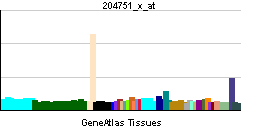DSC2
| Desmocollin 2 | |||||||||||
|---|---|---|---|---|---|---|---|---|---|---|---|
| Identifiers | |||||||||||
| Symbols | DSC2 ; ARVD11; CDHF2; DG2; DGII/III; DKFZp686I11137; DSC3 | ||||||||||
| External IDs | Template:OMIM5 Template:MGI HomoloGene: 8397 | ||||||||||
| |||||||||||
| RNA expression pattern | |||||||||||
 | |||||||||||
 | |||||||||||
| More reference expression data | |||||||||||
| Orthologs | |||||||||||
| Template:GNF Ortholog box | |||||||||||
| Species | Human | Mouse | |||||||||
| Entrez | n/a | n/a | |||||||||
| Ensembl | n/a | n/a | |||||||||
| UniProt | n/a | n/a | |||||||||
| RefSeq (mRNA) | n/a | n/a | |||||||||
| RefSeq (protein) | n/a | n/a | |||||||||
| Location (UCSC) | n/a | n/a | |||||||||
| PubMed search | n/a | n/a | |||||||||
Desmocollin 2, also known as DSC2, is a human gene.[1]
The protein encoded by this gene is a calcium-dependent glycoprotein that is a member of the desmocollin subfamily of the cadherin superfamily. These desmosomal family members, along with the desmogleins, are found primarily in epithelial cells where they constitute the adhesive proteins of the desmosome cell-cell junction and are required for cell adhesion and desmosome formation. The desmosomal family members are arranged in two clusters on chromosome 18, occupying less than 650 kb combined. Alternative splicing results in two transcript variants encoding distinct isoforms.[1]
References
Further reading
- Buxton RS, Cowin P, Franke WW; et al. (1993). "Nomenclature of the desmosomal cadherins". J. Cell Biol. 121 (3): 481–3. PMID 8486729.
- Arnemann J, Spurr NK, Wheeler GN; et al. (1991). "Chromosomal assignment of the human genes coding for the major proteins of the desmosome junction, desmoglein DGI (DSG), desmocollins DGII/III (DSC), desmoplakins DPI/II (DSP), and plakoglobin DPIII (JUP)". Genomics. 10 (3): 640–5. PMID 1889810.
- Parker AE, Wheeler GN, Arnemann J; et al. (1991). "Desmosomal glycoproteins II and III. Cadherin-like junctional molecules generated by alternative splicing". J. Biol. Chem. 266 (16): 10438–45. PMID 2037591.
- Garrod DR, Fleming S (1990). "Early expression of desmosomal components during kidney tubule morphogenesis in human and murine embryos". Development. 108 (2): 313–21. PMID 2112455.
- Nuber UA, Schäfer S, Schmidt A; et al. (1995). "The widespread human desmocollin Dsc2 and tissue-specific patterns of synthesis of various desmocollin subtypes". Eur. J. Cell Biol. 66 (1): 69–74. PMID 7750520.
- Amagai M, Wang Y, Minoshima S; et al. (1995). "Assignment of the human genes for desmocollin 3 (DSC3) and desmocollin 4 (DSC4) to chromosome 18q12". Genomics. 25 (1): 330–2. PMID 7774948.
- Kawamura K, Watanabe K, Suzuki T; et al. (1994). "cDNA cloning and expression of a novel human desmocollin". J. Biol. Chem. 269 (42): 26295–302. PMID 7929347.
- Buxton RS, Wheeler GN, Pidsley SC; et al. (1994). "Mouse desmocollin (Dsc3) and desmoglein (Dsg1) genes are closely linked in the proximal region of chromosome 18". Genomics. 21 (3): 510–6. doi:10.1006/geno.1994.1309. PMID 7959727.
- Theis DG, Koch PJ, Franke WW (1993). "Differential synthesis of type 1 and type 2 desmocollin mRNAs in human stratified epithelia". Int. J. Dev. Biol. 37 (1): 101–10. PMID 8507556.
- Marsden MD, Collins JE, Greenwood MD; et al. (1997). "Cloning and transcriptional analysis of the promoter of the human type 2 desmocollin gene (DSC2)". Gene. 186 (2): 237–47. PMID 9074502.
- Greenwood MD, Marsden MD, Cowley CM; et al. (1997). "Exon-intron organization of the human type 2 desmocollin gene (DSC2): desmocollin gene structure is closer to "classical" cadherins than to desmogleins". Genomics. 44 (3): 330–5. doi:10.1006/geno.1997.4894. PMID 9325054.
- King IA, Angst BD, Hunt DM; et al. (1997). "Hierarchical expression of desmosomal cadherins during stratified epithelial morphogenesis in the mouse". Differentiation. 62 (2): 83–96. PMID 9404003.
- Marcozzi C, Burdett ID, Buxton RS, Magee AI (1998). "Coexpression of both types of desmosomal cadherin and plakoglobin confers strong intercellular adhesion". J. Cell. Sci. 111 ( Pt 4): 495–509. PMID 9443898.
- Kurzen H, Moll I, Moll R; et al. (1998). "Compositionally different desmosomes in the various compartments of the human hair follicle". Differentiation. 63 (5): 295–304. PMID 9810708.
- Dias Neto E, Correa RG, Verjovski-Almeida S; et al. (2000). "Shotgun sequencing of the human transcriptome with ORF expressed sequence tags". Proc. Natl. Acad. Sci. U.S.A. 97 (7): 3491–6. PMID 10737800.
- Chen X, Bonne S, Hatzfeld M; et al. (2002). "Protein binding and functional characterization of plakophilin 2. Evidence for its diverse roles in desmosomes and beta -catenin signaling". J. Biol. Chem. 277 (12): 10512–22. doi:10.1074/jbc.M108765200. PMID 11790773.
- Syed SE, Trinnaman B, Martin S; et al. (2002). "Molecular interactions between desmosomal cadherins". Biochem. J. 362 (Pt 2): 317–27. PMID 11853539.
- Bloor DJ, Metcalfe AD, Rutherford A; et al. (2002). "Expression of cell adhesion molecules during human preimplantation embryo development". Mol. Hum. Reprod. 8 (3): 237–45. PMID 11870231.
- Strausberg RL, Feingold EA, Grouse LH; et al. (2003). "Generation and initial analysis of more than 15,000 full-length human and mouse cDNA sequences". Proc. Natl. Acad. Sci. U.S.A. 99 (26): 16899–903. doi:10.1073/pnas.242603899. PMID 12477932.
| This protein-related article is a stub. You can help Wikipedia by expanding it. |